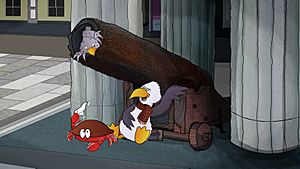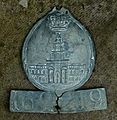Clock Tower, Herne Bay facts for kids
Quick facts for kids Clock Tower, Herne Bay |
|
|---|---|

Clock tower, 2006
|
|
| General information | |
| Architectural style | Eclectic, neoclassical |
| Location | Central Parade, Herne Bay, Kent, CT6 5JJ |
| Country | England |
| Coordinates | 51°22′23″N 1°07′35″E / 51.37306°N 1.12639°E |
| Elevation | 20.5 m (67 ft) |
| Construction started | 3 October 1836 |
| Opened | 2 October 1837 |
| Cost | 5,000 GBP |
| Client | Herne Bay Urban District Council |
| Owner | City of Canterbury |
| Height | 77 ft (23 m) excl. weather vane 85 ft (26 m) incl. weather vane. |
| Design and construction | |
| Architect | Edwin James Dangerfield |
| Structural engineer | Ambrose Hukins |
| Awards and prizes | Grade II listed |
The Clock Tower, Herne Bay is a famous landmark in Herne Bay, Kent in England. It was built in 1837. People believe it's one of the very first free-standing clock towers built just for that purpose in the United Kingdom.
This special tower was paid for by a generous lady named Mrs. Ann Thwaytes. Today, it also acts as a memorial to soldiers who lost their lives in the Second Boer War.
Contents
Who Built the Clock Tower?
Ann Thwaytes (1789–1866) was a wealthy widow from London. She often visited Herne Bay between 1834 and 1840. She stayed with a friend, Mr. Camplin, on Central Parade.
Ann Thwaytes became a very important helper for the town. In 1836, she gave £4,000 to build the Clock Tower. The total cost might have been £5,000. There's a special blue plaque near the tower that remembers her.
How the Idea Started
The Clock Tower was planned soon after Herne Bay's first pier was finished in 1832. The town was becoming very popular back then.
Historians think the tower's design might have been inspired by the Royal Exchange tower in London. Mrs. Thwaytes knew this building well. In 1836, she asked a young architect, Edwin James Dangerfield, to draw plans for a tower. She wanted it to look like an ancient Greek temple with a clock at the top.
About the Clock Tower Building
Many people see the Clock Tower as a symbol of Herne Bay. It's thought to be one of the first free-standing clock towers built in the UK.
The tower is about 77 feet (23.5 meters) tall. If you include the weather vane on top, it's about 85 feet (26 meters) tall. The clock faces are 5 feet (1.5 meters) wide. Edwin James Dangerfield designed it, and Ambrose Hukins built it.
Its Unique Design
The Clock Tower was made a "listed building" in 1951. This means it's a special historical building. Its design is a mix of different styles, called eclectic.
Some people have criticized its design. But for the people of Herne Bay, it's a beloved part of their holiday town. It adds to the fun and relaxed feeling of the seaside.
How It Was Built
The tower needed very strong foundations because it's close to the sea. It was built on shingle, which is like small stones. This is why it cost about £5,000 to build.
The inside of the tower is made of brick, covered with Portland stone. On the building, you can read a message: The gift of Mrs Ann Thwaytes to this town 11 Oct A.D. MDCCCXXXVII. This means it was a gift from Mrs. Ann Thwaytes on October 11, 1837.
The Clock and Bell

The original clock mechanism, made in 1836, is now on display at the Herne Bay Museum and Gallery. It was replaced in 1971.
The clock had to be wound twice a week. A person would climb 66 steps to reach the winding mechanism. They would turn a crank many times to keep the clock going.
The bell inside the tower was made in 1837. It weighs about 12 hundredweight (around 600 kg). This bell is still working in the tower today!
In 1971, an electric clock system was put in. This meant no one had to climb up to wind the clock anymore.
History of the Clock Tower
Laying the First Stone
On October 3, 1836, Mrs. Ann Thwaytes laid the first stone of the tower. Many people came to watch. There was a procession with local children and a military band.
Mrs. Thwaytes also gave a free dinner to 500 charity children and their parents. In the afternoon, there were boat races and a tightrope show. In the evening, there was a big firework display on the pier.
The Grand Opening
The Clock Tower officially opened on October 2, 1837. This was Mrs. Thwaytes' 48th birthday! There was a huge arch decorated with flags near the tower.
Mrs. Thwaytes arrived in a carriage, with music playing and people cheering. She gave the Clock Tower to the town. Cannons on the pier fired salutes. There was another free meal for children and workers. In the evening, there was a firework show.
Early Years

After 1900, two old cannons were placed at the base of the tower. These cannons were found on the seabed while the third pier was being built. They used to fire blanks to warn ships in fog.
A special plaque was added to the tower after 1902. It remembers the 36 local volunteers from Herne Bay who died in the Second Boer War.

The 20th Century
The Clock Tower was officially listed as a Grade II building in 1951. This helps protect it. The area around the tower has faced problems with erosion from the sea. In the 1990s, a sea defense called Neptune's Arm was built to protect it.
For a while, the tower helped hold up some of the seafront lights. A CCTV camera was also placed on top around the year 2000.
Fixing and Improving the Tower
2009 Repairs
In 2009, someone complained that the clock wasn't working. The local council fixed it completely within a month!
Recent Repairs
In 2012, the City of Canterbury Council started a big project to fix the tower. It had been damaged by salt water and strong winds. They got some money from the National Lottery to help.
The plan was to fix the tower between April and August 2014. They also wanted to add webcams to show views of the seafront and even the inside of the clock! They planned to add LED lights to make the tower look pretty at night.
A group called "Friends of Herne Bay Clock Tower" was created. These volunteers help teach people about the tower and keep it special.
The Clock Tower in Culture
The Clock Tower Plaza has been a place for fun events. In 2013, a flash mob performed the Harlem Shake there. The Clock Tower even got its own Twitter account!
In 2014, the Friends of Herne Bay Clock Tower asked an author to write a children's book called Tales From the Clock Tower. It tells stories about the tower. This book was later made into an audio book. It was even sent to local schools to help kids learn.
In 2015, the book was turned into an animation! It showed many places around Herne Bay as seagulls and a crab explored the town's history. The film had a special showing at a local cinema. The Clock Tower and the town are featured in this fun short film.
Images for kids







